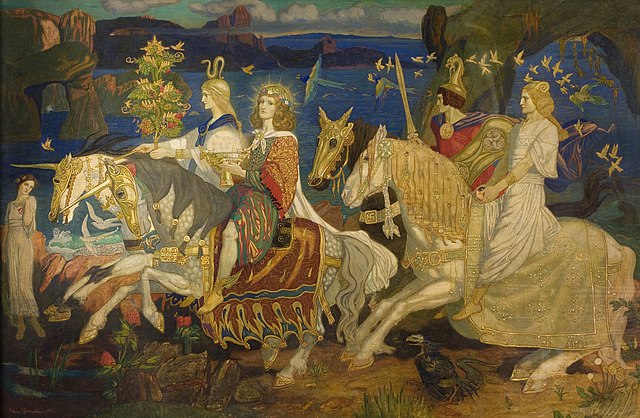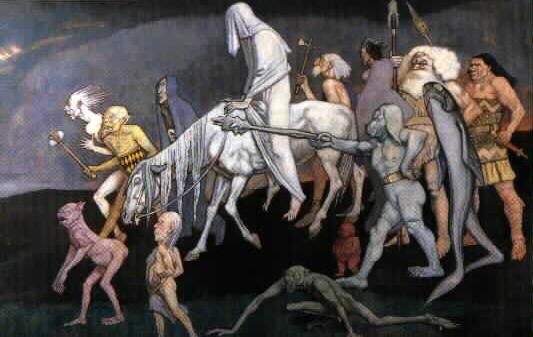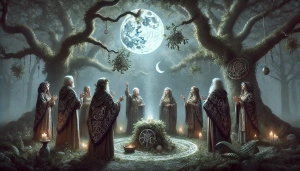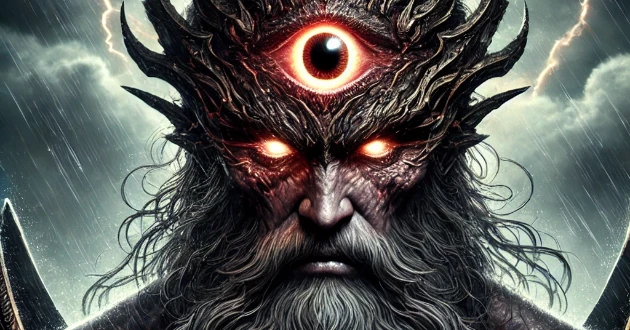The Story of the Second Battle of Moytura
Ireland’s old stories from Irish Mythology contain magic, mystery, and mighty heroes. Before modern times, the land was said to be home to otherworldly beings, powerful gods, and fierce warriors.
One of the most significant conflicts in these tales is known as the Second Battle of Moytura. This battle wasn’t just a clash of swords—it was a struggle between ancient forces, each fighting for control of Ireland’s destiny.
In the stories passed down through generations, the Second Battle of Moytura shows us how Ireland was shaped by the bravery, skills, and clever thinking of the early gods known as the Tuatha Dé Danann.
They faced off against fearsome opponents, including the monstrous Fomorians. Today, many people still share these old myths for excitement and to keep alive the spark of Irish culture, reminding us of Ireland’s deep-rooted connection to its land, people, and past.
Long ago, before the world took the shape we know, Ireland was a land of swirling mists and profound, ancient powers. The sky was vast and unsettled, and the earth seemed to hum with hidden magic.
In these early days, a great struggle unfolded—a momentous clash destined to echo through the ages of storytellers’ tongues. The Second Battle of Moytura was when two mighty forces met to decide Ireland’s fate.
Table of Contents
The Gathering of the Tuatha Dé Danann

They came silently and mysteriously into Ireland, the Tuatha Dé Danann—an otherworldly people of unsurpassed skill in craft and magic. When they arrived, they let their ships burn behind them, orange flames licking at the dusk, thick coils of smoke drifting toward the stars.
They had come to stay and shape the land according to their vision. They were tall and fair, their hair braided with strange metals, their cloaks woven with patterns of starlight. They settled across the green hills and by quiet lakes, forging alliances with the earth and sky.
In the early days, the Tuatha Dé Danann fought and vanquished the Fir Bolg, who had held Ireland before them. That was the First Battle of Moytura, where King Nuada lost his arm and thus his right to rule.
Yet even that deep wound could not undo their destiny. Dian Cécht, the physician-god, made Nuada a limb of pure, glittering silver. He reigned again as Nuada Airgetlám—Nuada of the Silver Hand—and under his guidance, the people prospered.
Across the breadth of the island, they raised shining palaces, forged swords of uncanny sharpness, and called forth music so pure that the hills trembled with delight.
The Threat of the Fomorians

But there were older powers in Ireland. Beneath the coastal mists and beyond the western horizon, the Fomorians lurked—an ancient race, monstrous and primordial. They were as much part of the land’s raw ferocity as the crashing waves on its stony shores.
Some said they had skin rough as bark and heads twisted with horns or tusks. Others whispered that they were shape-shifters, dreadful giants with powers of decay and terror. They were not simply pirates or raiders; they were the manifestation of chaos, forces that demanded tribute, submission, and fear.
For a time, the Tuatha Dé Danann reached uneasy compromises, paying tithes and yielding what they must to stave off the Fomorian threat. But Balor of the Evil Eye, the Fomorian warlord-king, hungered for total dominion.
His single giant eye, kept closed by heavy lids, was said to release a burning, withering gaze when opened—enough to slay armies, scorch fields, and turn spring rain to ash. The stalemate frayed, and both sides knew that the day of reckoning neared.
The Council at Tara
As dark clouds thickened in the west, Nuada summoned his people to council at the great hill of Tara. Beneath carved pillars and drifting incense, they gathered: the Dagda, father of plenty, with his great club and cauldron of never-failing sustenance; Ogma, champion of strength and the inventor of letters; Dian Cécht, who knew how to heal any wound; Morrígan, the fierce war-goddess who took the form of crows and ravens; and many others, each bearing gifts of wisdom and skill.
Into the hall, a youth with a shining face, eyes keen with a thousand crafts. He had come from distant learning to pledge service: Lugh Lámfada, Lugh of the Long Arm, grandson of Balor himself.
He was a master of every art—harpist, smith, warrior, sorcerer, poet. It was said that no skill existed he did not hold. Many doubted his youth, but Nuada knew Lugh’s time had come. The king yielded his seat so Lugh could guide their host in the coming trial.
Marshalling for War

The days before the battle were filled with furious preparation. The blacksmiths’ forges burned red-hot as swords were hammered, spearheads sharpened, and shields strengthened with enchanted carvings.
Druids chanted under oak groves by moonlight, weaving protective charms. Healers stocked herbs and prepared salves that glowed faintly with healing light. The Dagda strode from camp to camp, encouraging warriors with hearty words and feasting them on food from his bottomless cauldron.
Morrígan soared overhead, calling forth omens in the shrill cries of ravens. Lugh tested each warrior’s skill, spurring them to impossible feats, ensuring that none but the finest would stand on the battlefield.
A hush fell over the Tuatha Dé Danann camp on the eve of the conflict. A strange silence pressed upon them as dew shimmered on the grass. Torches flickered against linen tents, and beyond, distant drums signalled the Fomorians’ grim advance.
The Morrígan whispered prophecies of victory and doom, her voice drifting on the night wind. Lugh climbed a hill to watch the moon, thinking of the grandfather he must face and the land whose future weighed upon his every choice.
The Field of Moytura

When dawn’s pale light broke over Mag Tuired, the two armies stood opposite each other—phantom shapes forming lines across a plain that sloped toward a quiet lake. The Tuatha Dé Danann were a vision of ordered might, their armour gleaming in early sunbeams, their banners embroidered with mystic symbols.
The Fomorians stood like a wave of darkness, their silhouettes jagged, their weapons stained with old blood. Behind them loomed Balor, tall as a standing stone, his eyelid weighted down by warriors who held it closed with iron hooks and chains.
At Lugh’s signal, horns sounded. The armies crashed together, and the morning air erupted in cries, sword-clash, and spell-fire. Druids sang words that made the grass rise up as snares. Spears of gleaming bronze whirled in deadly arcs.
The Dagda’s booming laughter was heard as he smashed his club into monstrous shapes. Ogma shouted words of power that broke enemy lines. Every Tuatha Dé Danann deed was met by ferocious Fomorian cunning; gargantuan champions pushed forward, hurling boulders and roaring curses.
From the centre of the field, Nuada battled valiantly, silver hand flashing like a blade of moonlight. He fought until Balor himself strode forth. The sight of the Fomorian king was dreadful—gnarled muscles, twisted horns, and that swollen, deadly eye.
In that terrible clash, Balor’s lash of a barbed spear found Nuada’s breastplate. The king fell, life slipping from him into the red-stained grass. A cry of despair and fury went up from the Tuatha Dé Danann. They faltered, stepping back, uncertain.
The Turning of the Tide

Into this moment of dread stepped Lugh. He approached the towering Fomorian king with a steady stride, who commanded his guards to haul open the heavy eyelid. Rusty chains and enormous levers strained. As Balor’s foul eye began to open, a sickening green light spilt forth, burning the ground bare. Warriors of the Tuatha Dé Danann crumpled in agony, caught in its line of destruction.
But Lugh, quicker than thought, hurled his spear—a weapon crafted with all the arts he knew, blessed by druids, honed by master smiths, and aimed with the precision of a poet’s final word. The spear struck Balor’s eye before fully opening, twisting it in its socket.
Balor’s head whipped backwards with a thunderous groan, and the deadly gaze turned upon his own ranks, cutting swaths of chaos through the Fomorian lines. Giants screamed and fled. The dark tide wavered.
Seizing the opportunity, Lugh advanced, leading the Tuatha Dé Danann forward. The Dagda’s club crashed down, Morrígan shrieked triumph from above, and the warriors of Ireland’s future pressed the broken enemy like blacksmiths hammering hot iron.
Seeing their great king wounded beyond healing, the Fomorians began a ragged retreat, stumbling over their fallen and retreating to distant shores and shadows. The field lay strewn with remnants of that day’s ferocity: shattered shields, scorched ground, and the still, quiet forms of the fallen.
Aftermath and Legacy
As the victors tended their wounded and mourned their dead, Lugh knelt by Nuada’s body. The silver arm glinted in the dying light. The Tuatha Dé Danann honoured their fallen king with gentle words and solemn rituals.
In time, Lugh would lead them into a new age of wisdom, art, craftsmanship, and justice. After the second Battle of Moytura, the Tuatha Dé Danann were the true lords of Ireland, having overcome not just one challenger but the primal forces of chaos that threatened the land’s future.
In later centuries, poets and storytellers would evoke this battle’s name as they sat by hearth fires. Listeners would imagine Lugh’s spear whistling through the air, the Morrígan’s shrill cry of prophecy, and Balor’s terrible eye sealed forever.
They would recall how the Tuatha Dé Danann claimed their rightful place, forging the Ireland of legend—a land blessed and guarded by gods who knew both the price of power and the virtue of victory hard-won.
Thus ended the Battle of Moytura, and thus began the chapter of Ireland shaped by the hands of those divine craftsmen and warriors. It will never be forgotten.
Legacy of the Battle of Moytura
The Battle of Moytura wasn’t just a fight over land or power; it was a turning point that helped shape the Ireland we know through its stories and traditions. After the Tuatha Dé Danann secured their victory, Ireland was said to enter a golden age of prosperity and learning. Many of the god-like figures who fought at Moytura became symbols of wisdom, strength, and innovation.
Over time, their story was passed from one generation to the next, not only through poems and songs but also through the quiet telling of tales around fires on long winter nights. These stories kept Irish culture alive, reminding people that their heritage was built on courage and clever thinking.
Even now, when we look back at the Battle of Moytura, we see it as more than just an ancient myth—it’s a window into how the people of Ireland understood themselves, their land, and the magic that binds them together.
Further Reading and Exploration:
- Translations of the Táin Bó Cúailnge
- The Story of Ireland by Neil Hegarty
- Early Irish Myths and Sagas by Jeffrey Gantz
- A New History of Ireland: Prehistoric and Early Ireland, edited by Dáibhí Ó Cróinín
- The Knighting of Cú Chulainn
- Birth of Cú Chulainn
